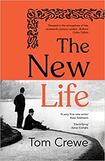
Tom Crewe’s debut novel opens with an illicit erection, pressed against another man’s buttocks on a crowded train in Victorian London. It’s one of several electrically erotic sex scenes in The New Life, illustrating gay desire at a time when acting upon it was an imprisonable offence.
Set between 1894 and 1896, The New Life toggles between the stories of two writers promoting progressive ideas around sexuality. John Addington is a 50-year-old married man who has had fleeting encounters with men. Henry Ellis, 30, is straight but has a paraphilia that leads him to advocate for non-procreative sex. He embarks on a platonic marriage with Edith, who takes women as lovers.
Addington and Ellis strike up a correspondence about homoeroticism in Ancient Greece and Walt Whitman’s poetry. They decide to collaborate on a book normalising homosexuality, including case studies of gay men. Their optimism about the book’s reception portrays a period of hope scuppered by the 1895 trials of Oscar Wilde (whose cross-examination is excerpted in The New Life to great effect).
Despite the increased anxiety after Wilde’s imprisonment, Addington is emboldened to live out his desires. Admiring the nude bathers at the Serpentine one afternoon, he makes the acquaintance of a younger working-class man. He eventually moves his lover into his house in Paddington, not giving his wife, Catherine, any choice in the matter.
‘It’s a stunning setting for any cafe, but this one has extra-special credentials’
Met Gala 2025 in pictures: Barry Keoghan and Andrew Scott fly Irish flag while Diana Ross leads with opulence
Adam Loughnane asked for help at a Galway hospital. Three hours later he was dead
Lottie Ryan on family life in an apartment: ‘It is very likely our forever home’
The sex scenes between the two men are a rallying cry for Henry’s belief that ‘the sex instinct might be a great engine for happiness, if only it could be liberated from shame’
As tension builds towards the denouement, the characters’ interests are not entirely aligned. John, who feels he is “dying” of “middle-class propriety”, is willing to risk his freedom for the right to live openly and set a positive example for others. Edith’s lover, Angelica, supports him in his outspokenness, while Henry, Edith and the book’s printer are more reluctant to stake their futures on the cause.
Through the stories of the two couples, Crewe places the fight for gay rights alongside other activist causes. Henry and Edith first meet at the Society of the New Life [(inspired by the Fellowship for the New Life, from which the Fabian Society would splinter off)]. The society promotes unconventional ways of living, although, as the characters find, the ideal of nonmonogamy has challenges in practice. Henry, Edith and Angelica struggle to find a balance, and “the New Life has come too late for Catherine”, John admits.
While the close third-person narration makes us empathise with John’s plight, the cost of his choices to his family is never minimised. “Is the injustice that I have suffered the stuff of a book?” Catherine asks. She, too, has been lonely, and accuses her husband of having used her body as “merely flesh, fitted to receive [his] waste”.
In addition to embodying “the new life” in her marriage, Edith holds popular lectures on modern women and relations between the sexes. British men are “used to being ruthless,” she says. “The women aren’t. We don’t grab. We shouldn’t. But we have to, to make some room for ourselves.” Addington’s three daughters attend Newnham College, one of Cambridge’s first women’s colleges. As his youngest prepares to leave home, he wonders “whether her childish powers of command would survive… the knowledge of her smallness in the greater world”.
Period detail
An editor at the London Review of Books, Crewe has a PhD in 19-century British history – knowledge which shines through the period detail in The New Life. His prose is not only sensual but sensory, with a Jamesian knack for metaphor, including a thick fog that allows John and Frank to hold hands and steal a kiss in the street. In their unabashed eroticism, the sex scenes between the two men are a rallying cry for Henry’s belief that “the sex instinct might be a great engine for happiness, if only it could be liberated from shame”.
That The New Life resonates as so contemporary is an indictment that the fight for equal rights rages on, as recent rulings of the US Supreme Court and the global shrug to Qatar hosting the World Cup attest
The characters of John and Henry are loosely based on John Addington Symonds, a poet and critic, and the sexologist Havelock Ellis. The two men collaborated on a medical textbook called Sexual Inversion, published in 1897; however, dates and details have been changed. As Sexual Inversion was published after his death, Symonds’s family bought and destroyed all the copies, with his literary executor claiming that Symonds would not have published the book had he lived. The New Life, in which Addington lives to face the consequences of the book’s release, “is in a way an attempt to dramatise this as counterfactual,” Crewe has said.
Havelock Ellis lived on to challenge the taboos of the Victorian era, helping to pave the way for more progressive attitudes (with the exception, it’s worth noting, of his support of eugenics). That The New Life resonates as so contemporary is an indictment that the fight for equal rights rages on, as recent rulings of the US Supreme Court and the global shrug to Qatar hosting the World Cup attest. But even during dark times, Crewe’s characters insist, “we must live in the future we hope to make”.











